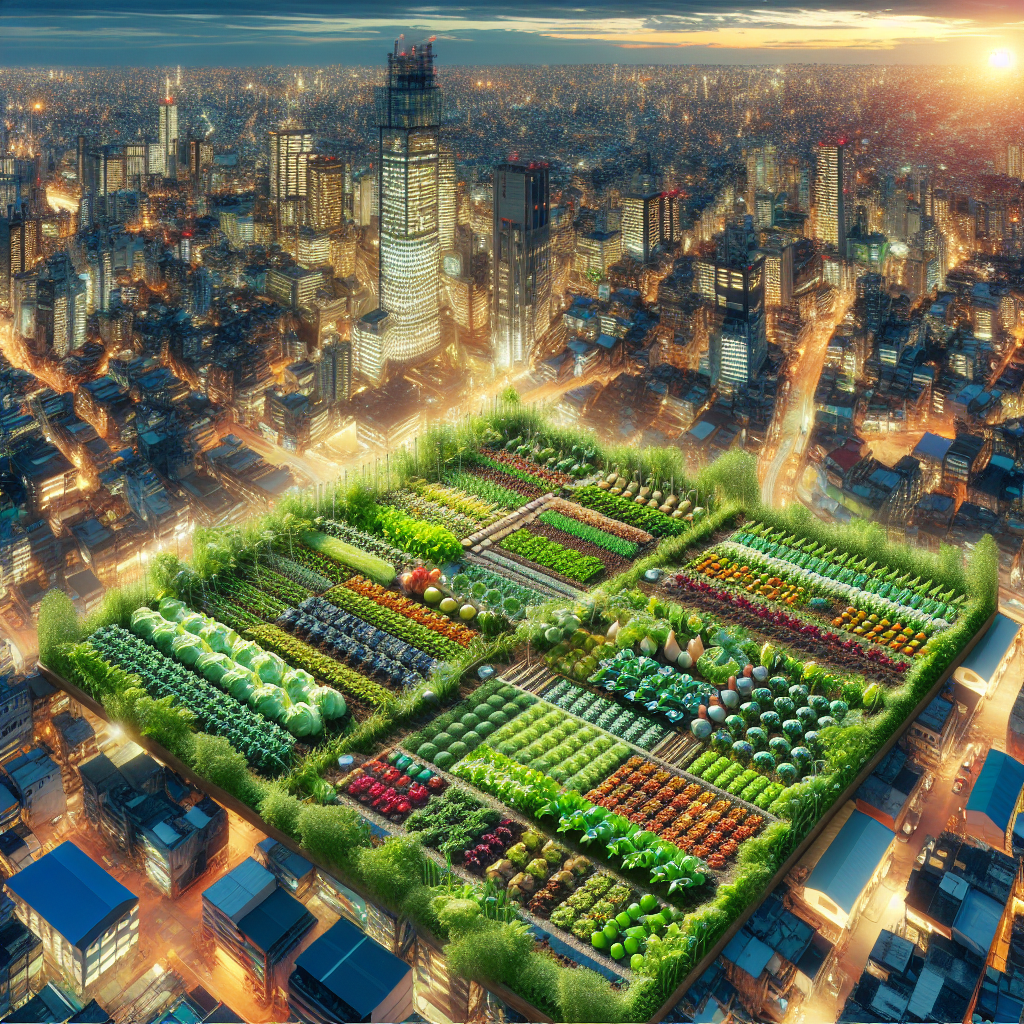
Urban farming is a potential game-changer in urban renewal and revitalization projects, unlocking a world of opportunities for communities to thrive. By bringing agriculture into the heart of city landscapes, we can foster sustainability, enhance food security, and create inclusive spaces for everyone. This article explores the transformative potential of urban farming, shedding light on the myriad benefits and innovative strategies that can be employed to harness its full potential. So, buckle up and get ready to discover how urban farming can reshape our cities for the better! Urban farming, also known as urban agriculture, has emerged as a promising solution to many of the challenges faced by today’s cities. As urban areas continue to expand and populations increase, the need for sustainable and equitable food production becomes more evident. Urban farming presents a unique opportunity to address these challenges by integrating food production into urban renewal and revitalization projects. By incorporating urban farming into urban planning, maximizing available space, implementing sustainable agriculture practices, fostering community engagement, and establishing partnerships and funding, cities can harness the benefits of urban farming in transforming themselves into sustainable, vibrant, and healthy communities.
Increased access to fresh and healthy food
One of the primary benefits of urban farming in urban renewal and revitalization projects is the increased access to fresh and healthy food. In many urban areas, residents face limited access to affordable and nutritious food options, leading to food deserts and health disparities. By integrating urban farming into these projects, cities can provide their residents with a local and reliable source of fresh produce. This not only improves the overall health and well-being of individuals but also promotes food security and reduces the reliance on long-distance food transportation, minimizing carbon emissions and environmental impact.
Potential for job creation and economic development
Urban farming also presents significant opportunities for job creation and economic development. By establishing urban farms and agricultural enterprises, cities can generate employment opportunities for local residents. These jobs can range from farming and cultivation to distribution and marketing, creating a diverse range of employment options. Moreover, urban farming can also stimulate the local economy by supporting local businesses, promoting entrepreneurship, and attracting investment. By leveraging urban farming as an economic driver, cities can strengthen their local economies while simultaneously addressing social and environmental challenges.
Improved community health and well-being
The integration of urban farming in urban renewal and revitalization projects has a profound impact on community health and well-being. By providing fresh and healthy food options, urban farming promotes healthy eating habits and addresses dietary-related health issues such as obesity and chronic diseases. Additionally, engaging in farming and gardening activities has been shown to have therapeutic benefits, reducing stress levels and improving mental well-being. Urban farms can also serve as community gathering spaces, fostering social connections and creating a sense of belonging. These positive social interactions contribute to overall community cohesion and support the development of resilient and inclusive communities.
Enhanced urban biodiversity and ecosystem services
Urban farming plays a crucial role in enhancing urban biodiversity and ecosystem services. By creating green spaces and habitats, urban farms provide refuge for diverse plant and animal species, contributing to the conservation of biological diversity in urban environments. Moreover, urban farms can act as urban green infrastructure, reducing the heat island effect, improving air quality, and mitigating stormwater runoff. These ecosystem services not only benefit the local environment but also contribute to the overall livability and sustainability of cities. By integrating urban farming into urban renewal projects, cities can transform their landscapes into thriving ecosystems that support both human and ecological well-being.
Integration of Urban Farming in Urban Planning
Incorporating green spaces and urban agriculture in city plans
An essential step in integrating urban farming into urban renewal and revitalization is incorporating green spaces and urban agriculture into city plans. This can be achieved by designating areas for urban farming within zoning regulations and land-use plans. By intentionally allocating space for urban farming in city planning, cities ensure that sufficient land is available for agricultural purposes. This may include the development of community gardens, urban farms, or urban agriculture districts. Moreover, city plans should also consider the integration of green spaces and urban farms into existing neighborhoods, ensuring equitable access to these resources for all residents.
Implementing zoning policies to support urban farming
To support the integration of urban farming, cities should implement zoning policies that facilitate and encourage agricultural activities. This may include relaxing zoning restrictions on land use and building codes to accommodate farming infrastructure such as greenhouses, hoop houses, and hydroponic systems. Additionally, cities can establish regulations that allow for the sale and distribution of produce grown on urban farms, promoting local food systems and supporting direct-to-consumer sales. By creating an enabling environment through zoning policies, cities can incentivize and promote urban farming as a viable land use option.
Collaborating with local community organizations and stakeholders
Collaboration with local community organizations and stakeholders is vital to the successful integration of urban farming in urban planning. Engaging residents, community groups, and non-profit organizations in the planning and decision-making process ensures that the needs and aspirations of the community are considered. This collaboration can take the form of participatory workshops, public consultations, and partnerships with local organizations that have expertise in urban agriculture. By involving the community in the planning and implementation of urban farming initiatives, cities can foster a sense of ownership and empower residents to take an active role in shaping their neighborhoods.
Urban Farming Techniques for Urban Renewal Projects
Rooftop and vertical farming
Rooftop and vertical farming are innovative techniques that maximize space utilization in urban areas. Rooftop farms make use of the vast, underutilized spaces on the tops of buildings, converting them into productive agricultural areas. These farms can range from small-scale rooftop gardens to larger commercial operations, depending on the available space. Vertical farming, on the other hand, involves growing crops in stacked layers or vertically inclined surfaces such as walls or pillars. These techniques use advanced technologies such as hydroponics or aeroponics, which provide optimal conditions for plant growth. Rooftop and vertical farming offer substantial opportunities for urban farming in densely populated urban areas where land availability is limited.
Community gardens and allotments
Community gardens and allotments have long been recognized as valuable resources for urban communities. These spaces provide opportunities for individuals and groups to grow their own food and connect with nature. Community gardens promote social interaction, knowledge sharing, and a sense of belonging, contributing to community well-being. Allotments, on the other hand, are individual plots of land that are assigned to residents for cultivation purposes. These plots allow individuals to have a dedicated space for gardening and food production. Community gardens and allotments not only provide fresh and locally grown produce but also foster food sovereignty and resilience in urban communities.
Hydroponics and aquaponics systems
Hydroponics and aquaponics systems are soilless farming techniques that use nutrient-rich water to grow plants. Hydroponics involves growing plants in a water-based nutrient solution, while aquaponics combines hydroponics with aquaculture, where fish or other aquatic animals are reared. In aquaponics systems, the waste produced by the fish provides nutrients for the plants, creating a mutually beneficial relationship. These techniques offer several advantages for urban farming, including higher crop yields, reduced water usage, and year-round production. Hydroponics and aquaponics systems can be implemented in various settings, from rooftop farms to indoor facilities, making them versatile options for urban agriculture.
Indoor farming and controlled environments
Indoor farming and controlled environments refer to the practice of growing crops inside climate-controlled structures, such as greenhouses or vertical farms. By controlling factors such as temperature, humidity, and lighting, indoor farming allows for year-round cultivation and protects plants from extreme weather conditions and pests. This technique is particularly suited for urban areas where outdoor space is limited or unsuitable for farming. Indoor farms can use soil-based or soilless growing methods, depending on the specific crops and production goals. The controlled environment also enables the optimization of resource use, such as water and energy, making indoor farming a highly efficient and sustainable approach to urban farming.
Maximizing Available Space for Urban Farming
Utilizing vacant lots and brownfields
… (Continued…)







